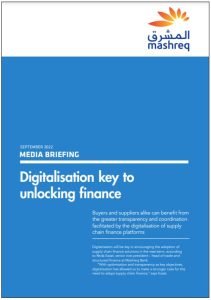Digitalisation can help close $1tn supply chain finance gap

Buyers and suppliers stand to benefit from the greater transparency and coordination enabled by the digitalisation of supply chain finance platforms, says Mashreq Bank
- Global study indicates $1tn gap between available supply chain finance and funds in use
- Digitalisation of supply chain finance can help unlock opportunities for both buyers and suppliers
- It enhances visibility and transparency for all those involved, building greater trust in the process
- Key drivers of such solutions include lenders (banks), fintech providers and buyers (corporates)
- Digital supply chain finance solutions are expected to constantly evolve in keeping with market requirements
Download the complete media briefing here
Digitalisation can help narrow the global gap between available supply chain finance and the funds currently in use, according to Reda Ezzat, senior vice-president – head of trade and structured finance at Mashreq Bank.
“There is a clear opportunity, a gap that we think can be bridged through the use of digital solutions in optimising the access to and implementation of supply chain finance products,” says Ezzat.
Nearly $1.8tn of supply chain finance is available globally, while only $713bn is currently in use, according to estimates by receivables finance analyst BCR Publishing.
Driven by both banks and corporate businesses, digital supply chain finance solutions have seen an increase in adoption in recent years.
“Supply chain finance has been around for a while, but it is really digitalisation of the process that has been the catalyst,” says Ezzat. “Technology has made the product much more viable, especially for corporates with deep and diversified supply chains.”
Studies conducted by McKinsey Global Company in 2020 highlight that more than 60 per cent of the total addressable trade finance market is concentrated in supply chain finance.
McKinsey further estimates that the future potential market for supply-chain finance stands at $17tn. The global gap in trade finance, however, further widened by the Covid-19 pandemic, could hamper access to this pool.
By introducing a technology platform as part of the wider product offering, banks and fintechs are now able to provide a more holistic value proposition that goes beyond merely financing against extended payment terms.
“Digitalisation allows greater visibility of cash flow, while complementing decision-making processes through the use of data analytics,” says Ezzat. “It also allows businesses to better align with reporting requirements.”

He also emphasises the need for CFOs and treasurers to recognise the value that supply chain finance can bring to the table and work jointly with their procurement partners to build more resilience and sustainability into their business.
“In an environment where the priority is to optimise the cost of finance, the relevant decision-makers must look at the bigger picture,” he says. “It is equally important to inculcate better buyer-supplier relationships, to build a more resilient ecosystem – and digital supply chain finance can be an effective way to do so.”
Download the complete media briefing here
This briefing is brought to you by the MEED-Mashreq Global Transaction Banking Partnership.
In case you have further queries about Mashreq’s supply chain finance solution, reach out to the team on: SCF@mashreq.com.


